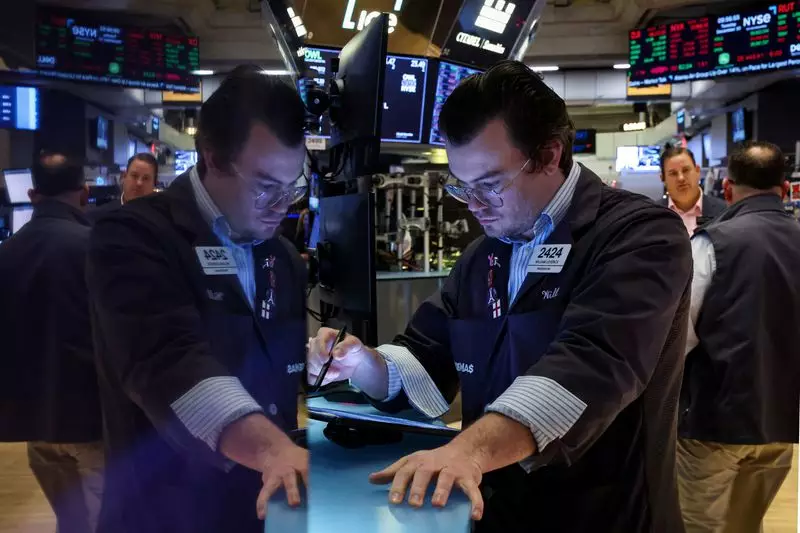In the ever-evolving landscape of Wall Street, recent developments indicate a significant upswing, particularly within the technology sector. A noteworthy catalyst for this resurgence was Broadcom’s earnings report, which not only exceeded Wall Street’s expectations but also projected an ambitious forecast for its custom artificial intelligence (AI) chips. This announcement resonated throughout the market, sending Broadcom’s stock soaring by over 21% and positioning the company to cross the monumental $1 trillion mark in market capitalization for the first time. Such milestones signal a growing investor sentiment towards AI, a sector that has become increasingly pivotal in contemporary financial discussions.
Investors, buoyed by Broadcom’s results, are viewing the AI domain as a goldmine of opportunities. Peter Andersen, founder of Andersen Capital Management, emphasized the trend of companies in the AI sector meeting and surpassing earnings expectations, thus fueling a cycle of investor enthusiasm. The excitement is palpable; however, it raises questions regarding the sustainability of such optimism. Are we witnessing a genuine economic revival, or is this a speculative bubble driven by fervent market anticipation?
Such enthusiasm within a single company can rapidly translate into broader market dynamics. Following Broadcom’s lead, other semiconductor stocks, such as Marvell Technology, also saw gains, reflecting a wave of investor confidence in tech equities. However, it’s essential to note that this rally is accompanied by a selective performance across various sectors. While technology indicators showed strength, a closer examination reveals that seven of the eleven S&P sub-sectors experienced declines. This paints a picture of a market that remains sensitive to fluctuations and highlights the disparate performance indicators among various industries.
The Nasdaq Composite, buoyed by the tech rally, surpassed the pivotal 20,000 mark, further emphasizing the pronounced trend towards technology investments. Such movements contrast sharply with the less dynamic performance of traditional sectors, reaffirming the bifurcation in market sentiment. This divergence suggests a potential volatility that investors must navigate cautiously.
As Wall Street navigates these highs, significant attention is being paid to potential changes from the Federal Reserve regarding interest rates. An in-line reading of inflation data has led to widespread speculation regarding a 25-basis-point cut in the upcoming Federal Reserve meeting. Current trader expectations, at over 96%, suggest a leaning towards this immediate action. However, experts like Ermengarde Jabir from Moody’s caution against a hasty approach, indicating that straying from a long-term economic outlook based on fleeting data trends might spur unintended consequences.
The complexities arising from the Federal Reserve’s policy decisions exemplify the intricate balance that must be maintained in a recovering economy. Investors are left parsing through economic indicators that could prompt monetary adjustments, underscoring the need for strategic foresight.
Amid these financial currents, the political landscape remains a compelling variable influencing market dynamics. The aftermath of Donald Trump’s electoral victory has stoked optimism among investors, as many posit that his approach may catalyze more favorable business conditions. The speculation surrounding potential policy shifts amplifies the sense of buoyancy in the market, though it also raises concerns about the potential volatility these changes may induce.
Amidst these overarching trends, specific stocks are making headlines. Salesforce’s 1.4% uptick following an upgrade from KeyBanc reflects the ongoing enthusiasm for cloud-based services and software, while a reported 14.5% surge for RH following positive revenue results highlights the diversity of growth opportunities in the current market ecosystem. This characterization of the market is critical; it reveals a landscape where specific sectors can thrive independently, even in a mixed performance environment.
While the recent performance of Wall Street, particularly within the technology sector, suggests a resurgence fueled by AI-related prospects, caution is warranted. The volatility within other sectors, coupled with looming Federal Reserve actions and political influences, creates a complex tapestry of potential outcomes. As investors maneuver through this robust yet fickle market, discerning long-term trends from short-lived enthusiasm will be crucial. The current market landscape may be bright, but strategic vigilance remains key to navigating the uncertain waters ahead.

